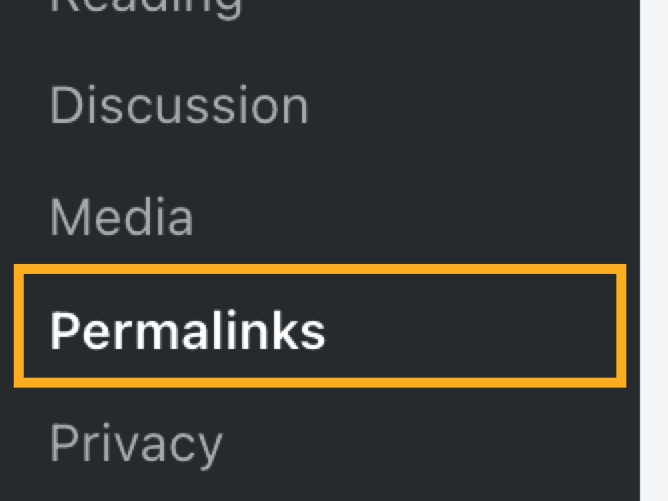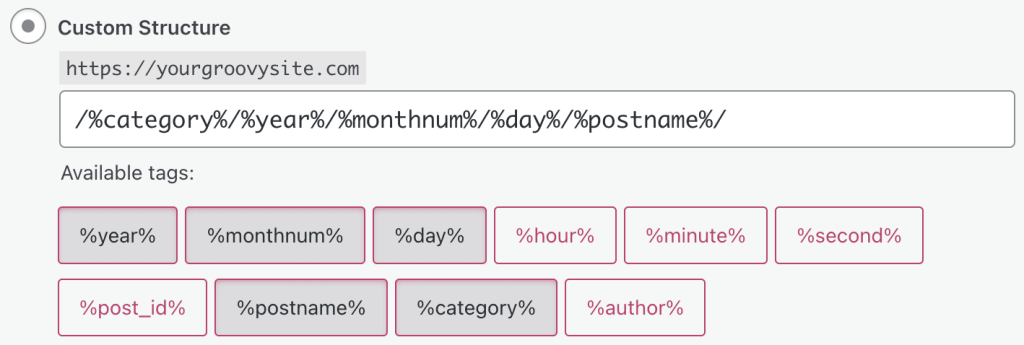A permalink structure, short for “permanent link structure,” refers to the format used to create the link, or URL for individual posts, pages, or other content on a website. This guide will explain how to change the permalink structure for the blog posts on your site.
This feature is available on sites with the WordPress.com Creator or Entrepreneur plan. If your site has one of our legacy plans, it is available on the Pro plan.
In this guide
This is an example of a permalink for a blog post:
https://yourgroovydomain.com/2024/01/01/first-blog-post
In the example above, the section /2024/01/01/first-blog-post is part of the “permalink structure”. Plugin-enabled sites can use a custom permalink structure. For example, you can change the permalink structure to display just the blog post name, or slug of the permalink, e.g: https://yourgroovydomain.com/first-blog-post
If you want to customize the slug (or the last section of the URL e.g: first-blog-post in the example above) of the permalink address, you can follow the steps in this guide.
By default, WordPress creates post URLs with the date and name or title of the post. You can customize this URL structure of your site’s blog post links (i.e., the permalinks) to adjust the aesthetics and usability of your post links.
Take the following steps to customize your site’s permalinks:
- Ensure your site has an eligible plan that has been activated.
- From your dashboard, go to Settings → Permalinks.
- Navigate to the Permalinks structure section.
- Choose from one of the following permalink structures:
- Plain
- Day and name
- Month and name
- Numeric
- Post name
- Custom structure
- Click the “Save Changes” button at the bottom of the screen.

If you do not see the “Permalinks” option in “Settings” in your dashboard, that means your site is not on a plugin-enabled plan.
⚠️
If changing from the default “Day and name” permalink setting to “Post name”, posts will not automatically redirect from the old links. To set this up, use a redirection plugin.
You can adjust the post links to any format you like, such as removing the date from the URL for example. To use the Custom Structure option for your permalinks:
- Ensure your site has an eligible plan that has been activated.
- From your dashboard, go to Settings → Permalinks.
- Navigate to the “Permalinks structure” section.
- Click the radio button next to the “Custom Structure” option.
- Click the button for each Available tag (see below) that you want to add the permalink in the order you want them to appear. For example, if you want the URLs to show only the title of the post, click on
%post_id%only. - Click the “Save Changes” button.

Below the Custom Structure option is a list of available tags. Each tag is a placeholder for the structure of your URL:
%year%– the year the post was published.%monthnum%– the numeric value of the published month.%day%– the numeric value for the day of the month.%hour%– the hour the post was published.%minute%– the minute the post was published.%second%– the second the post was published.%post_id%– the numerical value of the post, referred to as the “post ID”.%postname%– the “slug” of the post. The default slug is the title you gave your post, but if you changed the permalink the slug will be what you set up.%category%– the post’s category.%author%– the author of the post.
When a visitor navigates to a category or tags page, the URL will default to https://yourgroovysite.com/category/categoryname or https://yourgroovysite.com/tag/tagname.
If you want to change the word “category” or “tag” in the URL, take these steps:
- Ensure your site has an eligible plan that has been activated.
- From your dashboard, go to Settings → Permalinks.
- Navigate to the “Optional” section.
- Enter the Category base or Tag word you want to use.
- Click the “Save Changes” button.

To reset the category or tag base, clear out the text in the corresponding field (leaving it blank) and click the “Save Changes” button.
You may have additional options from plugins installed on your site. For example, if you have installed the WooCommerce plugin, you can change the permalink structure for product URLs.
Sometimes, you may encounter errors related to permalinks. A troubleshooting step you can take is to reset the permalinks by doing the following:
- From your dashboard, go to Settings → Permalinks.
- Under “Common Settings“, take note of your current permalink structure settings.
- Select a different permalink structure and click the “Save Changes” button.
- Reselect the permalink structure you initially had.
- Click the “Save Changes” button again to reset your permalinks.
